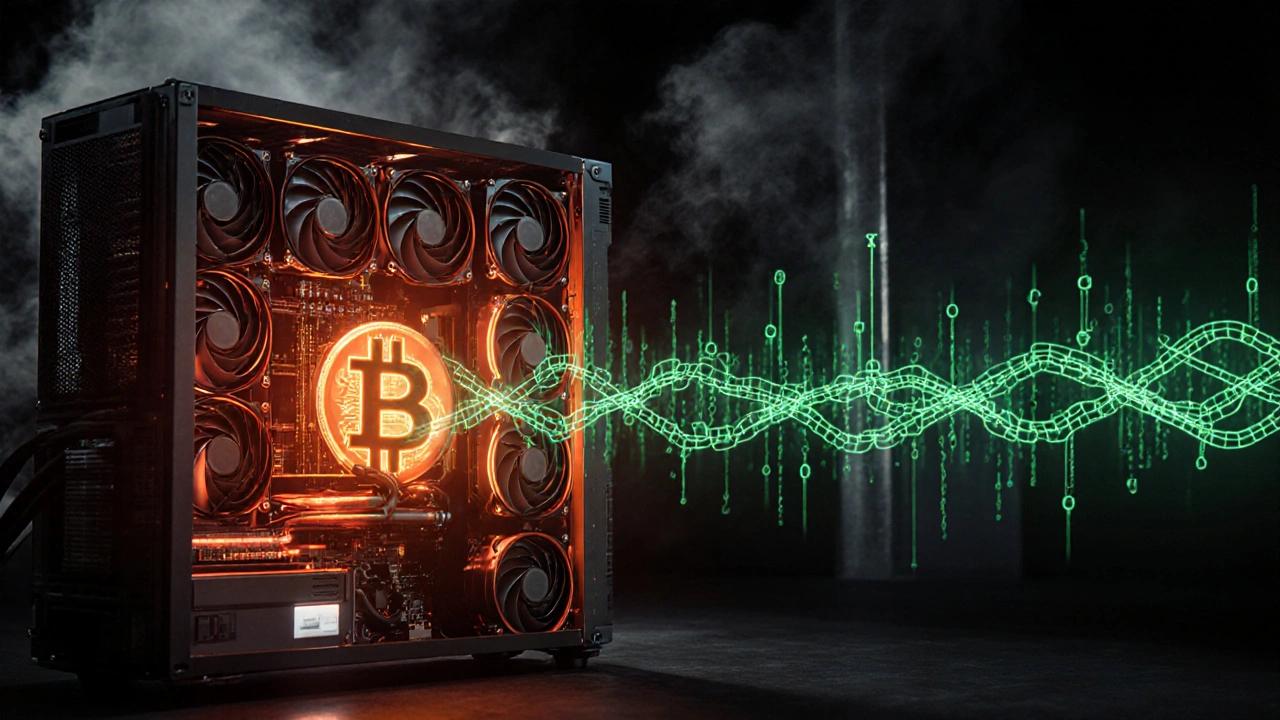When you send Bitcoin to a friend, you’re not emailing money. You’re not transferring files. You’re not even logging into a bank. You’re updating a public record that millions of computers around the world agree on. That record is the blockchain. And it’s what makes cryptocurrency possible.
What Is a Blockchain?
A blockchain is a digital ledger. Not the kind you find in a spreadsheet or a bank’s database. This one is distributed. It lives on thousands of computers at once. Every time a transaction happens - like Alice sending 0.5 BTC to Bob - it gets bundled with other transactions into a block. That block is then added to the chain of previous blocks. Once it’s there, it can’t be changed.
Think of it like a public notebook. Everyone has a copy. Every time someone writes a new entry, everyone else checks it. If it’s valid - if Alice actually had the Bitcoin to send - the entry gets stamped and locked in. No one can erase it. No one can fake it. That’s the core of blockchain: trust without a middleman.
How Transactions Get Verified
When you make a crypto transaction, it doesn’t go to a bank for approval. It goes out to a network of computers called nodes. These nodes are volunteers - anyone can run one. They’re watching for new transactions. When one pops up, they check three things:
- Is the sender’s digital signature valid? (Only the person with the private key can sign a transaction.)
- Does the sender have enough coins? (Every node checks the full history of the blockchain.)
- Is this transaction already spent? (No double-spending allowed.)
If all checks pass, the transaction gets queued up with others to be added to the next block. This is where mining comes in - but not in the way most people think.
The Role of Mining
Mining isn’t about digging for gold. It’s about solving a hard math puzzle. Miners - people with powerful computers - compete to find a specific number that, when combined with the block’s data, produces a hash that meets strict criteria. It’s like rolling dice until you get a triple six. The first miner to solve it gets to add the block to the chain.
Why does this matter? Because it takes real work. Electricity. Time. Hardware. That cost makes it expensive to cheat. If someone tried to alter an old block, they’d have to redo all the math for every block after it - and they’d need more computing power than the entire network combined. That’s nearly impossible.
In return for their work, miners get rewarded with newly created cryptocurrency. For Bitcoin, that’s currently 3.125 BTC per block (as of 2025). That’s how new coins enter circulation. It’s also how the network pays people to keep it secure.

Why Decentralization Matters
Before blockchain, digital money needed a central authority. PayPal, banks, credit card companies - they all acted as gatekeepers. They could freeze accounts, reverse transactions, or charge fees. Blockchain removes all of that.
No single company owns it. No government controls it. The rules are written in code and enforced by the network. If you own Bitcoin, you own the private key. That’s your password. That’s your bank. That’s your identity. No one else can touch it unless you give them access.
This changes everything. People in countries with unstable banks can store value without fear of seizure. Freelancers can get paid instantly, without waiting days or paying 5% in fees. Even small businesses can accept global payments without needing a merchant account.
What Makes Blockchain Secure?
Security doesn’t come from encryption alone. It comes from structure. Each block contains:
- A list of transactions
- A timestamp
- A reference to the previous block’s hash (a unique digital fingerprint)
That last part is the magic. If you change even one letter in an old transaction, the hash of that block changes. That breaks the link to the next block. And since every node has a copy of the chain, they’ll instantly spot the mismatch. The altered block gets rejected. The network moves on.
It’s like a chain of dominoes. Knock over one, and the whole line falls. But here, the dominoes are spread across the world. To fake a transaction, you’d have to change the domino in every single copy at the same time. That’s why blockchain is called tamper-evident.
Blockchain vs. Traditional Databases
It’s easy to think blockchain is just a fancy database. But it’s not. Here’s how they differ:
| Feature | Blockchain | Traditional Database |
|---|---|---|
| Control | Distributed across many users | Controlled by one organization |
| Alterations | Impossible after confirmation | Can be edited or deleted |
| Transparency | Publicly viewable (in most cases) | Private, internal access only |
| Speed | Slower (5-10 minutes per block for Bitcoin) | Instant (milliseconds) |
| Cost | Transaction fees (paid to miners) | Operational costs (paid by the company) |
Traditional databases are faster and cheaper. But they’re also vulnerable. If a bank’s server gets hacked, your money is at risk. If a blockchain node gets hacked, nothing changes. The network keeps running. The data stays intact.

Real-World Use Beyond Bitcoin
Bitcoin was the first. But blockchain does more than just move coins. Ethereum, for example, lets developers build apps on top of the blockchain. These apps - called dApps - can handle loans, games, voting systems, even supply chains.
Companies like Walmart use blockchain to track food from farm to shelf. If there’s a contamination, they can trace the source in seconds instead of days. Hospitals use it to securely share patient records without giving full access to everyone. Even artists sell digital art as NFTs - unique tokens on the blockchain that prove ownership.
The technology isn’t perfect. It’s slow. It uses a lot of energy. But its strength isn’t speed. It’s reliability. It’s honesty. It’s a system that works even when no one trusts each other.
What Happens If You Lose Your Key?
This is the dark side of decentralization. If you lose your private key, there’s no customer service. No password reset. No bank to call. The Bitcoin stays locked in that wallet forever. Estimates suggest over 20% of all Bitcoin is already lost this way.
That’s why people use hardware wallets - small devices that store keys offline. Or seed phrases - 12-24 random words that can restore access. Write them down. Keep them safe. Don’t screenshot them. Don’t email them. If you do, you’re not using blockchain. You’re just trusting someone else again.
Is Blockchain the Future?
It’s not a magic fix. It won’t replace your credit card tomorrow. But it’s changing how we think about ownership, trust, and control. In a world where data leaks, fraud, and censorship are common, blockchain offers something rare: proof that something happened - without needing permission.
For cryptocurrency, it’s the foundation. Without blockchain, Bitcoin is just a number. With it, it’s money that belongs to you - not a company, not a government, not a server in a data center somewhere.
The technology is still young. But it’s growing. And it’s working - exactly as it was designed to.
Can blockchain be hacked?
The blockchain itself hasn’t been hacked. But exchanges and wallets have. The network is secure because changing data would require controlling more than half the computing power on the entire network - something that’s never been done for Bitcoin. However, if you store your crypto on an exchange or use a weak password, you’re vulnerable. The blockchain protects the ledger. You have to protect your keys.
Why does blockchain use so much energy?
Bitcoin uses proof-of-work mining, which requires massive amounts of electricity to solve complex math puzzles. In 2025, Bitcoin’s annual energy use is estimated at around 120 terawatt-hours - similar to the entire country of Argentina. But many newer blockchains, like Ethereum, switched to proof-of-stake in 2022, cutting energy use by over 99%. Energy isn’t a flaw of blockchain - it’s a design choice.
Is cryptocurrency the same as blockchain?
No. Cryptocurrency is one use of blockchain. Blockchain is the technology. Cryptocurrency is the application. You can have blockchain without crypto - like tracking medicine supply chains. But you can’t have cryptocurrency without blockchain. The ledger is what gives digital money its value and security.
How fast are blockchain transactions?
It depends on the network. Bitcoin confirms a block every 10 minutes. Ethereum takes around 12 seconds. Some newer chains like Solana can do over 50,000 transactions per second. But speed isn’t the point. The point is security and decentralization. Fast doesn’t mean safe. Blockchain trades speed for trust.
Can governments shut down blockchain?
No. There’s no central server to shut down. The blockchain runs on thousands of computers worldwide. Even if one country bans it, the network keeps running elsewhere. Governments can ban exchanges or make crypto illegal to use locally, but they can’t delete the blockchain. It’s like trying to delete the internet by shutting down one ISP.



poonam upadhyay
November 8, 2025 AT 14:54Blockchain? More like blockchain BS. Everyone acts like it’s magic but it’s just a glorified spreadsheet run by nerds with too much electricity and zero chill. And don’t get me started on the energy waste-Argentina? Try entire continents. This isn’t innovation, it’s a cult with a whitepaper.
Shivam Mogha
November 8, 2025 AT 23:13Decentralization means responsibility. Lose your key, you lose everything. No one’s coming to save you.
mani kandan
November 10, 2025 AT 16:49What’s fascinating isn’t the tech itself, but how it flips the script on trust. We used to need institutions to vouch for value. Now, math and consensus do it. That’s revolutionary-even if it’s clunky.
Rahul Borole
November 11, 2025 AT 08:14The architectural elegance of blockchain lies in its immutability and distributed consensus mechanisms. By eliminating single points of failure, it redefines the paradigm of digital trust. This is not merely a technological advancement-it is a civilizational shift in how value is authenticated and preserved across human systems.
Sheetal Srivastava
November 12, 2025 AT 16:00Let’s be honest-this is just crypto’s Trojan horse. The blockchain is the infrastructure, sure, but the real agenda? Financial colonization under the guise of decentralization. You think you own your Bitcoin? You’re just a node in a Wall Street 2.0 algorithm. The ‘trustless’ system is just a new kind of surveillance capitalism with more buzzwords.
Bhavishya Kumar
November 13, 2025 AT 20:28You wrote 'hash that meets strict criteria'-should be 'meets a strict criterion.' Also, 'proof-of-work' needs hyphens throughout. Minor, but accuracy matters when explaining foundational tech.
ujjwal fouzdar
November 14, 2025 AT 19:02Think about it-what if the real revolution isn’t the blockchain, but the fact that we’re finally willing to believe in something we can’t see, touch, or control? We used to need priests, kings, banks… now we trust code. That’s not tech. That’s religion with a whiteboard.
Anand Pandit
November 15, 2025 AT 10:57Love how this breaks it down so clearly. So many people think crypto is just gambling, but the real power is in giving people control over their own money. Especially in places where banks are corrupt or unstable. This could change lives.
Reshma Jose
November 16, 2025 AT 00:56Y’all act like mining is the only way but Ethereum switched to proof of stake and it’s way cleaner. Stop clinging to the past. We’re evolving.
rahul shrimali
November 16, 2025 AT 12:54Lost keys = lost money. Simple as that.
Eka Prabha
November 17, 2025 AT 23:58They say blockchain is tamper-proof, but what about the 51% attack? And don’t tell me it’s impossible-I’ve read the papers. The system relies on goodwill. What happens when the goodwill runs out? Governments, corporations, or a rogue state with enough GPUs could rewrite history. This isn’t secure-it’s optimistic.
Bharat Patel
November 19, 2025 AT 07:56It’s interesting how we’ve outsourced trust to machines. We used to trust neighbors, then banks, now we trust algorithms written by strangers in Silicon Valley. Maybe the real question isn’t how blockchain works-but why we’re so desperate to stop trusting each other.
Bhagyashri Zokarkar
November 20, 2025 AT 13:00so like… blockchain is just a chain of blocks right? and each block has like transactions and stuff? and if you change one thing it breaks the whole chain? but like… what if someone just… i dunno… hacked all the computers at once? and also why do miners get paid in new coins? isnt that just printing money? and also why does it take so long? like my bank transfers are instant. this feels like dial-up internet with a side of delusion.
OONAGH Ffrench
November 21, 2025 AT 08:16There’s a quiet elegance in systems that don’t need to be trusted. The blockchain doesn’t ask for faith-it demands verification. That’s why it survives where centralized systems collapse. It’s not about being faster or prettier. It’s about being unbreakable by design. The real tragedy isn’t lost keys-it’s that most people still don’t see this as anything more than a speculative asset. They miss the point entirely.
Rakesh Dorwal
November 21, 2025 AT 22:37Blockchain is a Western scam disguised as liberation. In India we’ve had hundis and hawalas for centuries-peer-to-peer trust without servers. Now you want us to pay fees to Americans running nodes? No thanks. Real freedom isn’t in code-it’s in community.